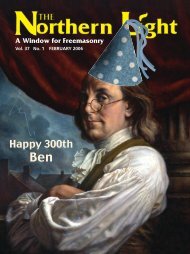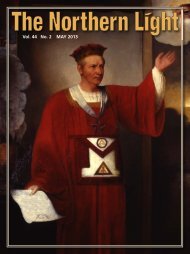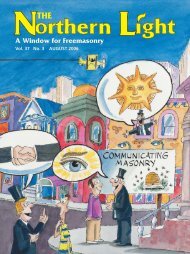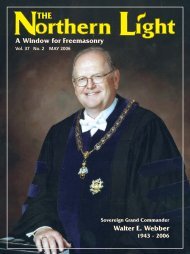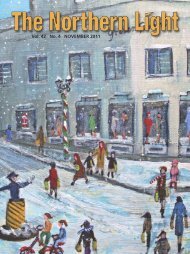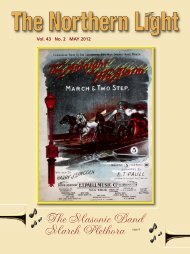The Degree Rituals The Supreme Council, 33 ... - Scottish Rite, NMJ
The Degree Rituals The Supreme Council, 33 ... - Scottish Rite, NMJ
The Degree Rituals The Supreme Council, 33 ... - Scottish Rite, NMJ
You also want an ePaper? Increase the reach of your titles
YUMPU automatically turns print PDFs into web optimized ePapers that Google loves.
<strong>The</strong> <strong>Degree</strong> <strong>Rituals</strong><br />
Good and Evil — <strong>The</strong> Nineteenth <strong>Degree</strong><br />
<strong>The</strong> 19°, “Grand Pontiff,” now the first of the Consistorial degrees, was<br />
one of the <strong>Rite</strong> of Perfection degrees recorded in the Francken Manuscript.<br />
In its earliest form, it consisted primarily of a kind of lecture with references<br />
to the “New Jerusalem” and other symbols from the New Testament Book of<br />
Revelation. Albert Pike’s ritual expanded on these elements to include a series<br />
of 12 lectures on the struggle between good and evil. <strong>The</strong> ritual of 1886 developed<br />
this theme into a dramatic allegory which forms the basis of the modern<br />
ritual. It introduced Philetus the Neophyte, his visit to the Shades, and<br />
the personified Spirits of Evil and of Masonry. This ritual continued intact<br />
until a shortened form appeared in 1953.<br />
After more than a century of presentations to <strong>Scottish</strong> <strong>Rite</strong> Masons, making<br />
it one of the longest running degree rituals in the Jurisdiction, the 19° ritual<br />
underwent major revisions. This process was not quickly or easily<br />
accomplished. Over a period of five years, commencing in 1988, a succession<br />
of five draft revisions were prepared. <strong>The</strong> primary author of these successive<br />
revisions was a clergyman, Ill. Richard C. Thistle, <strong>33</strong>°, a member of the Valley<br />
of South Bend and a consultant to the Committee on <strong>Rituals</strong>.<br />
In the course of these revisions, the ritual was rewritten in more contemporary<br />
language. An addition to the prologue explained the derivation of the<br />
word “Pontiff” from the Latin “pontifex,” literally “bridge-builder.” <strong>The</strong> appearance<br />
of the Spirit of Evil and his confrontation with the Spirit of Masonry<br />
were staged as a vision of the pontiffs. <strong>The</strong> obligation and the anointing were<br />
eliminated as anticlimactic to the principal action of the allegory, thereby setting<br />
a precedent that would be followed in subsequent revisions of other degree<br />
rituals. In place of these deletions, a charge was added at the close of the<br />
ritual. <strong>The</strong> fifth such revision was approved as the 19° Tentative Ritual of<br />
1993.<br />
For nine years the approved revision remained in limbo as the tentative ritual<br />
until it was superseded by a further revision, the 19° Ritual of 2002. <strong>The</strong><br />
2002 ritual retained the prologue and scenes one and two of the tentative<br />
ritual without change and made two minor deletions from dialogue in scenes<br />
three and five.<br />
47




